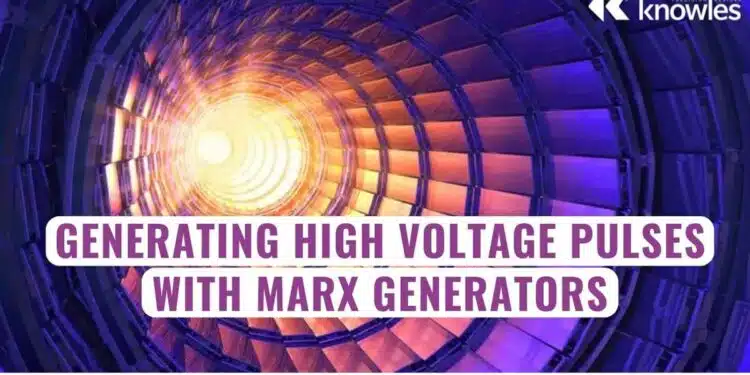This article based on Knowles Precision Devices blog explains how Marx generators play a critical role in generating high-voltage pulses by amplifying lower voltage DC inputs and capacitor guidelines for these type of applications.
Pulsed energy drives a diverse range of high-energy applications, from particle acceleration and fusion research to electromagnetic pulse (EMP) simulation. Marx generators play a pivotal role in generating these high-voltage pulses by amplifying lower voltage direct current (DC) inputs.
In this comprehensive guide, we’ll delve into the intricacies of Marx generator operation, explore recent advancements that enhance their efficiency and reliability, and highlight the pivotal role of capacitors in shaping their performance.
Within Marx generators, capacitors are charged in parallel using a low-voltage power source. Resistors or inductors are employed to control the charging rate and isolate the capacitors, ensuring they remain charged until a discharge is initiated.
When the voltage across the capacitors reaches the breakdown voltage of the spark gaps (i.e., the point where discharge is initiated), the spark gaps conduct, creating a temporary series connection of the capacitors. This configuration merges the voltages of all the capacitors, resulting in an output voltage significantly higher than the original charging voltage. The rapid and simultaneous discharge generates high-voltage pulses.
Innovating for Efficient and Simple Marx Generators
Ongoing research and development in Marx generator technology aims to simplify designs, enhance energy delivery efficiency, and broaden their functional capabilities.
Impedance-Matched Marx Generators (IMGs) are particularly suited for fusion and other next-generation pulsed-power systems due to their extended operational lifetimes, rapid rise times, and high repetition rates. Advancements in pulse shaping offer precise control over output waveforms, which is crucial for applications such as nonthermal plasma generation.
Integrating solid-state switching technology into Marx generators enhances their reliability without compromising their ability to meet the voltage and current requirements of advanced military and aerospace applications. For the same audience, there’s an ongoing effort to miniaturize Marx generators for space- and weight-constrained applications.
Capacitor Functions in Marx Generators
Capacitors play a crucial role in energy storage within Marx generators. When charged in parallel, each capacitor maintains the same voltage level while remaining isolated from the full output voltage until the discharge process commences. This configuration ensures efficient energy storage and controlled release.
During discharge, the series configuration enables capacitors to support voltage multiplication, resulting in the target output voltage. The output voltage is calculated as the sum of the voltages across each capacitor.
In conjunction with resistors, capacitors also influence discharge characteristics, such as the discharge rate. The RC time constant ensures that capacitors are fully charged before discharge begins, facilitating efficient energy transfer. Additionally, the capacitance value and configuration determine the speed at which energy can discharge through the load, providing control over pulse duration and shape.
Selecting Marx Generators
When choosing capacitors for Marx generators, consider:
- Voltage Rating: Choose capacitors rated 1.5 to 2 times the Marx generator’s maximum operating voltage to handle over-voltage and ensure reliability.
- Capacitance Value: Higher capacitance stores more energy but can increase pulse width and rise time. Match the capacitance to your output needs.
- Capacitor Type: Common capacitor types (i.e., ceramic, film, electrolytic) have inherent performance differences. Ceramic and film capacitors are ideal for high-frequency pulses due to their fast response and reliability under tough conditions.
- Operating Environment: Consider temperature and insulation needs to avoid performance issues in harsh conditions.
- Impedance Matching: Select capacitors with proper impedance for the best output voltage and performance.
Explore Knowles’ specialty film capacitors designed specifically for pulse energy applications. With their superior stability, durability and precision under extreme conditions, these capacitors are the perfect solution for demanding high-energy systems.


































